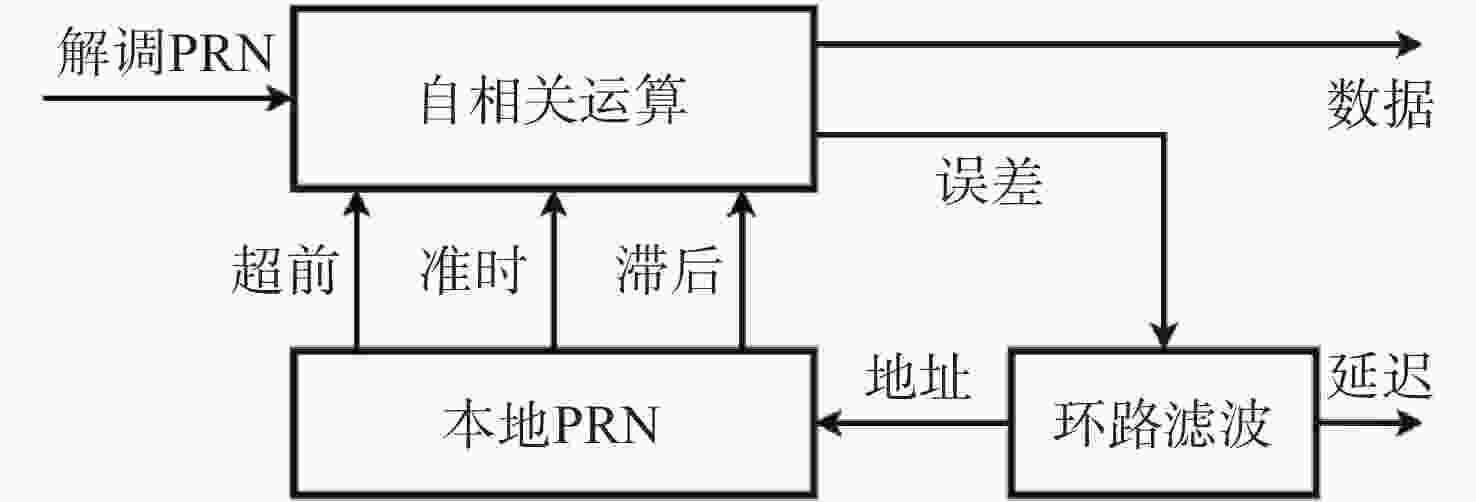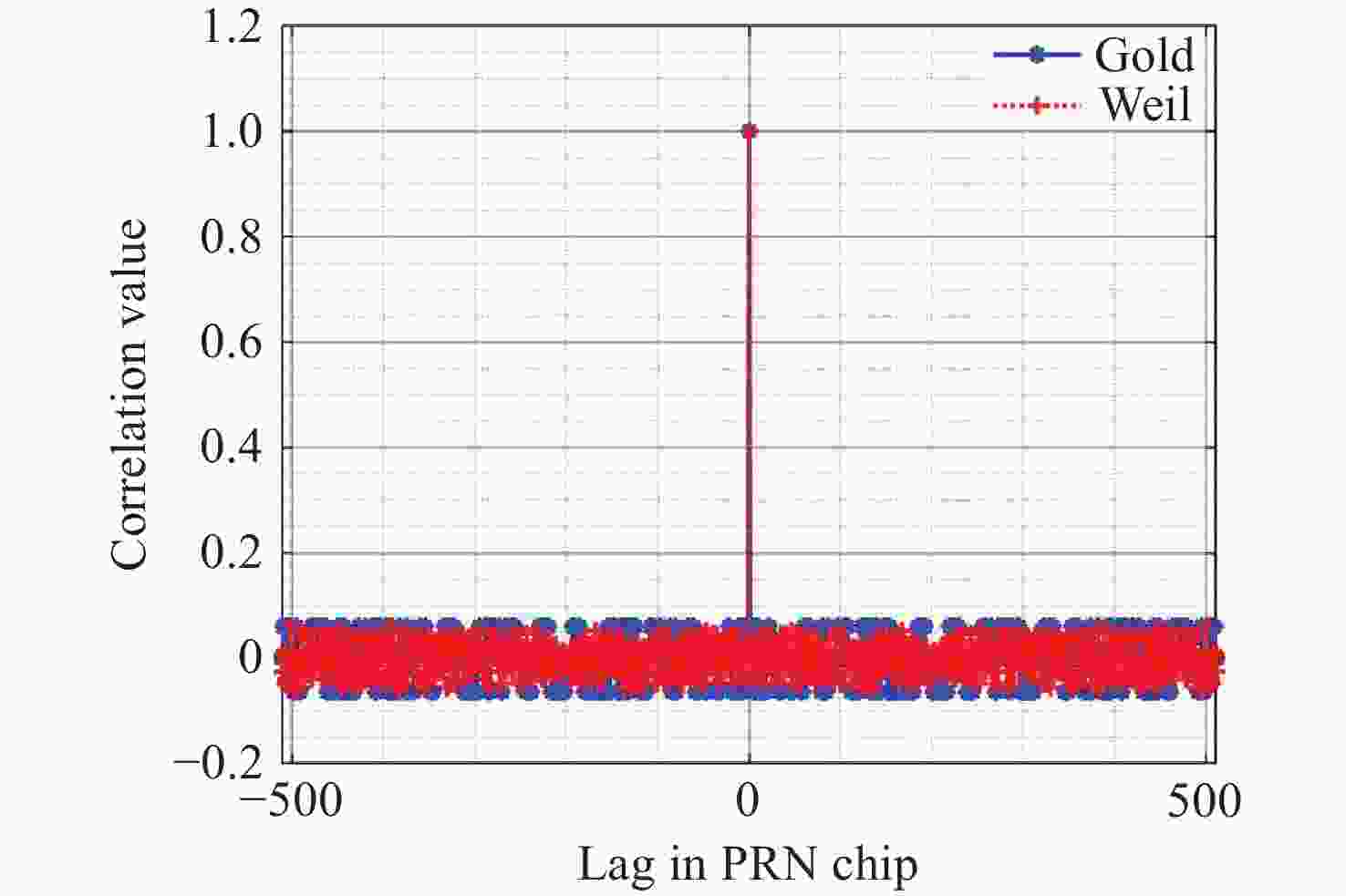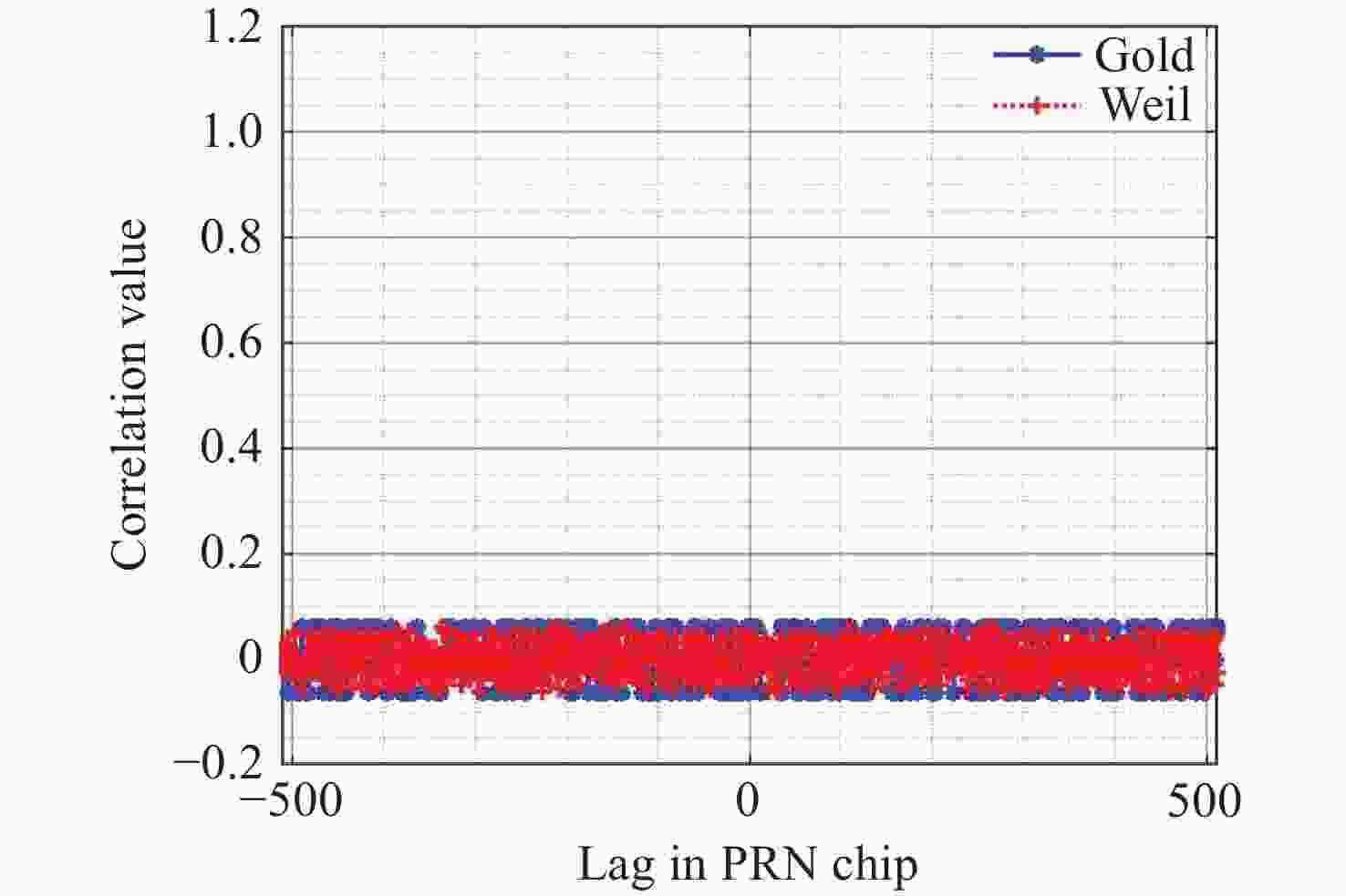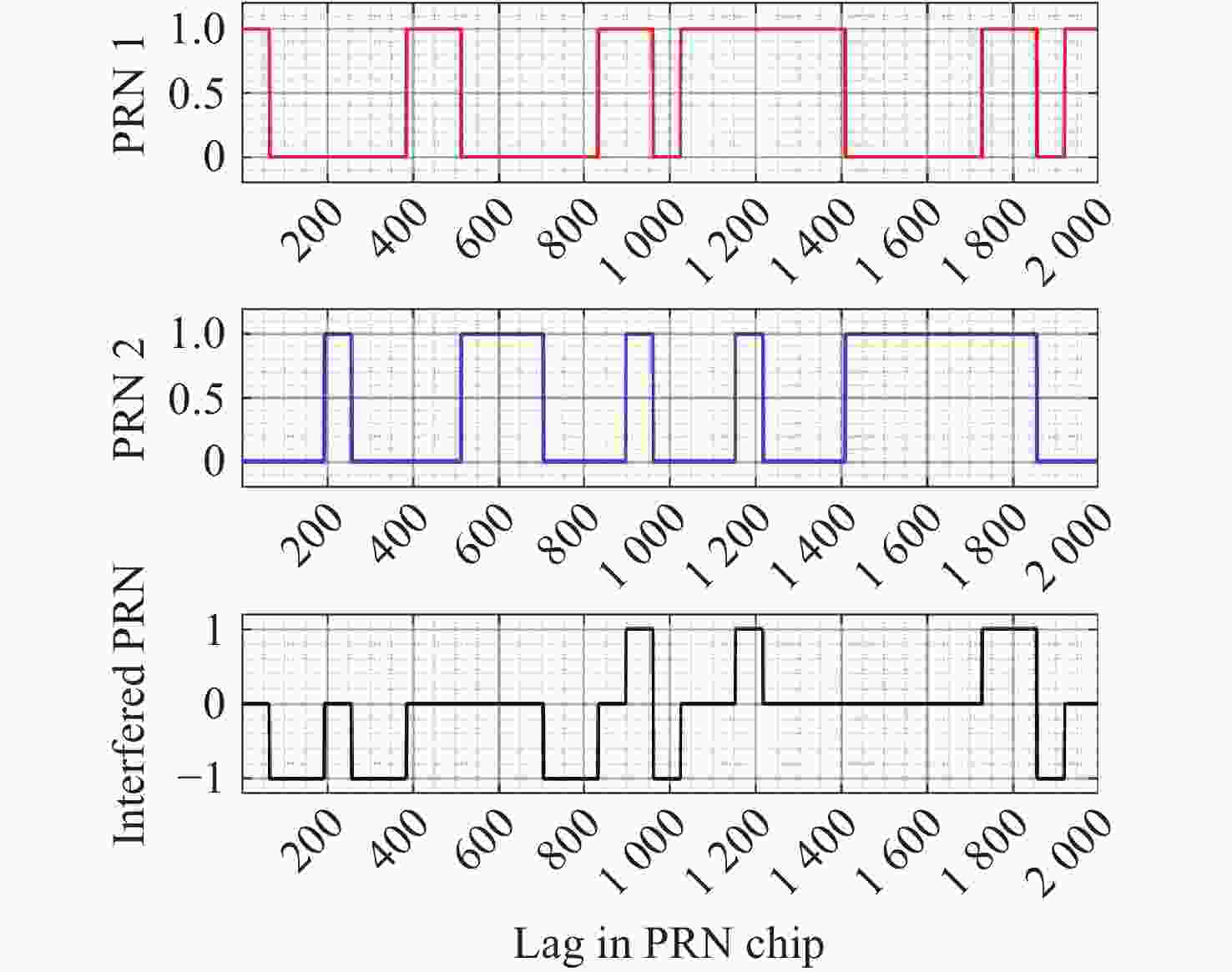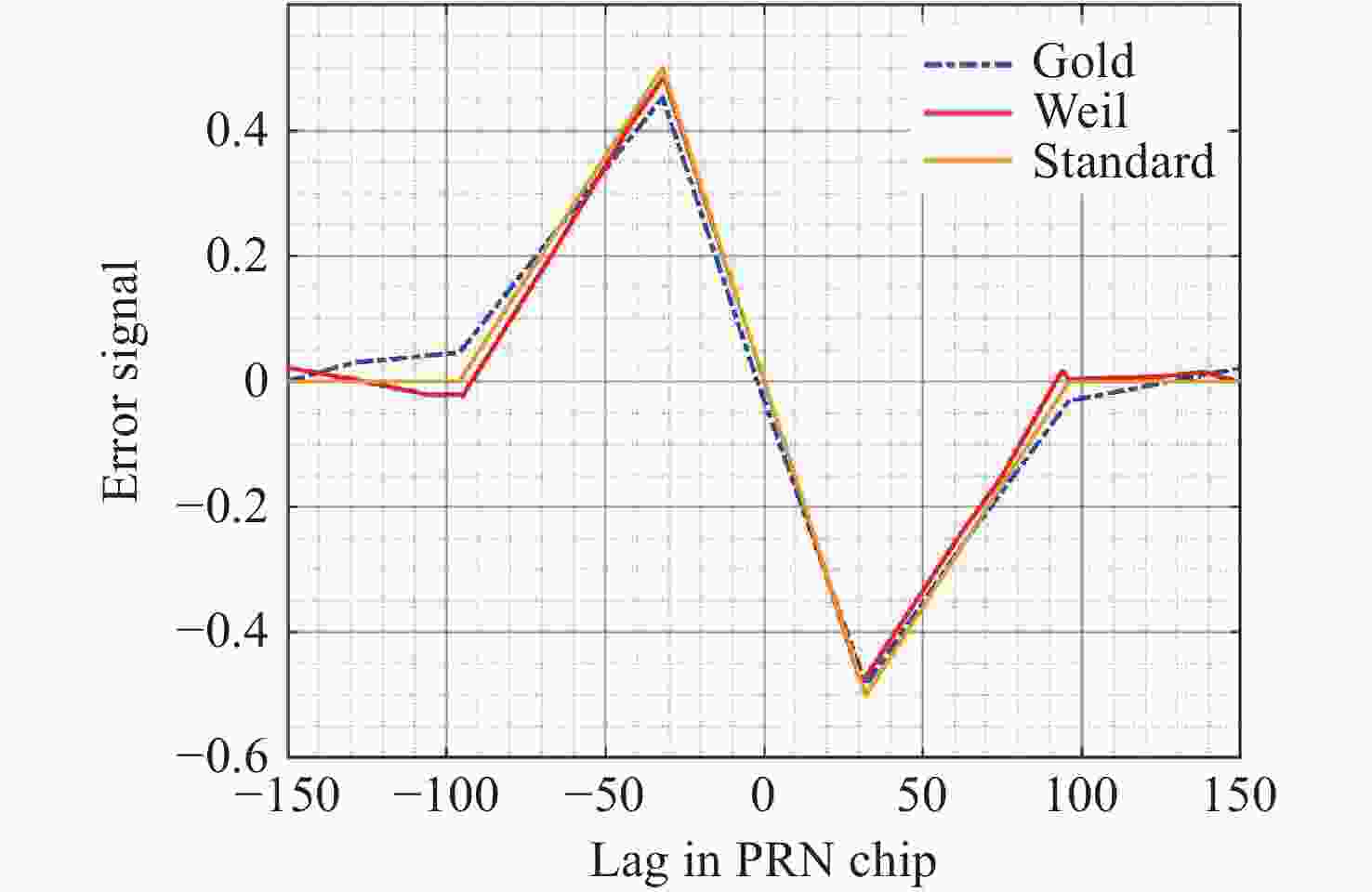Pseudo-random code selection for inter-satellite laser ranging and data communication in the Taiji program
-
摘要:
太极计划拟通过扩频通信技术,在干涉链路的基础上,实现星间的激光通信和绝对距离测量。伪随机码的选取是实现通信测距系统的第一步,需对不同的伪随机码的实现原理、相关性、测距误差函数等进行对比分析。本文首先介绍了m序列、Gold序列与Weil序列的生成原理,并采用不同的硬件结构和方法生成相应的伪随机序列,采用GPS的C/A码作为Gold序列与Weil序列进行比较分析选取。在FPGA开发平台实现用于生成Gold序列和Weil序列的硬件电路,并分析不同硬件实现方法的优劣与资源消耗情况。然后,分别计算Gold序列与Weil序列的相关值及其均方根误差,比较Gold序列与Weil序列的伪随机噪声性能。最后,基于测距原理和激光干涉后的码间串扰现象,构建用于测距的误差函数,与理想的误差函数作对比,分析用不同伪随机码测距的优势和劣势。数据表明:Weil序列相关值的旁瓣值范围为−60.27 dB至−24.01 dB、自相关rms为0.303、互相关rms为0.307,指标均优于Gold序列,消耗的硬件资源为Gold序列的30%,误差函数的偏差值更小。Weil序列更适合于太极计划的星间通信测距需求。
Abstract:The Taiji program aims to achieve inter-satellite laser communication and absolute distance measurement using spread spectrum phase modulation technology based on the interferometric laser link. The selection of pseudo-random codes is the initial step in the design and implementation of the ranging and communication system, which requires comprehensive research and comparison of various aspects, including the implementation principles, correlation properties, and ranging error functions associated with different pseudo-random codes. This paper first elucidates the generation principles of m-sequences, Gold sequences, and Weil sequences. Pseudo-random sequences are generated using different hardware structures such as Fibonacci, Galois, and register addressing. The hardware circuits for Gold and Weil sequence generation are implemented on an FPGA development platform. The GPS C/A code is used as the Gold sequence, which facilitates its comparison and analysis with the Weil sequence. An analysis of the resource consumption and complexity of different hardware implementation methods is performed. Then, correlation values and root mean square errors are calculated to compare the pseudorandom noise performance of the Gold and Weil sequences. Finally, an error function for ranging is constructed based on the ranging principles and the intersymbol interference phenomenon after laser interference. This function is then compared with the ideal error function to evaluate the advantages and disadvantages of using different pseudorandom codes for ranging. The analysis reveals that Weil sequences demonstrate superior performance, exhibiting a sidelobe range of −60.27 dB to −24.01 dB, an autocorrelation rms of 0.303, and a cross-correlation rms of 0.307, outperforming Gold sequences in all metrics. Additionally, Weil sequences require only 30% of the hardware resources of Gold sequences and have a smaller error function deviation. Weil sequences are better suited to the laser ranging and data communication requirements of the Taiji program.
-
表 1 相关值与均方根
Table 1. Correlation value and rms
码型 自相关值(dB) 自相关rms 互相关值(dB) 互相关rms Gold −60.20~−23.94 0.323 −60.20~−23.94 0.312 Weil −60.27~−24.01 0.303 −60.27~−24.01 0.307 -
[1] HU W R, WU Y L. The Taiji Program in Space for gravitational wave physics and the nature of gravity[J]. National Science Review, 2017, 4(5): 685-686. doi: 10.1093/nsr/nwx116 [2] 罗子人, 张敏, 靳刚, 等. 中国空间引力波探测“太极计划”及“太极1号”在轨测试[J]. 深空探测学报,2020,7(1):3-10.LUO Z R, ZHANG M, JIN G, et al. Introduction of Chinese space-borne gravitational wave detection program "Taiji" and "Taiji-1" satellite mission[J]. Journal of Deep Space Exploration, 2020, 7(1): 3-10. (in Chinese). [3] BAYLE J B, BONGA B, CAPRINI C, et al. Overview and progress on the Laser Interferometer Space Antenna mission[J]. Nature Astronomy, 2022, 6(12): 1334-1338. doi: 10.1038/s41550-022-01847-0 [4] ARMANO M, AUDLEY H, BAIRD J, et al. Sensor noise in LISA Pathfinder: an extensive in-flight review of the angular and longitudinal interferometric measurement system[J]. Physical Review D, 2022, 106(8): 082001. doi: 10.1103/PhysRevD.106.082001 [5] LUO J, CHEN L SH, DUAN H Z, et al. TianQin: a space-borne gravitational wave detector[J]. Classical and Quantum Gravity, 2016, 33(3): 035010. doi: 10.1088/0264-9381/33/3/035010 [6] Huang X Q, Wang G F, Yang M L, et al. Study on picometer-level laser interferometer readout system in TianQin project[J]. Optics & Laser Technology, 2023, 161: 109185. [7] WU H ZH, XU M Y, WANG P P, et al. Time delay interferometry with a transfer oscillator[J]. Optics Letters, 2023, 48(1): 9-12. doi: 10.1364/OL.473812 [8] 刘河山, 高瑞弘, 罗子人, 等. 空间引力波探测中的绝对距离测量及通信技术[J]. 中国光学,2019,12(3):486-492.LIU H SH, GAO R H, LUO Z R, et al. Laser ranging and data communication for space gravitational wave detection[J]. Chinese Optics, 2019, 12(3): 486-492. (in Chinese). [9] DELGADO E, JOSÉ J. Laser Ranging and Data Communication for the Laser Interferometer Space Antenna[M]. Granada: Universidad de Granada, 2012. [10] 辜方林, 彭进霖, 黄育侦, 等. 新型直接序列扩频通信方法[J]. 通信学报,2023,44(12):78-85. doi: 10.11959/j.issn.1000-436x.2023233GU F L, PENG J L, HUANG Y ZH, et al. Novel direct sequence spread spectrum communication method[J]. Journal on Communications, 2023, 44(12): 78-85. (in Chinese). doi: 10.11959/j.issn.1000-436x.2023233 [11] ESTEBAN J J, BYKOV I, MARÍN A F G, et al. Optical ranging and data transfer development for LISA[J]. Journal of Physics: Conference Series, 2009, 154: 012025. doi: 10.1088/1742-6596/154/1/012025 [12] XIE S Y, ZENG H Y, PAN Y H, et al. Bi-directional PRN laser ranging and clock synchronization for TianQin mission[J]. Optics Communications, 2023, 541: 129558. doi: 10.1016/j.optcom.2023.129558 [13] 邓汝杰, 张艺斌, 刘河山, 等. 太极计划中的星间激光测距地面电子学验证[J]. 中国光学(中英文),2023,16(4):765-776.DENG R J, ZHANG Y B, LIU H SH, et al. Ground electronics verification of inter-satellites laser ranging in the Taiji program[J]. Chinese Optics, 2023, 16(4): 765-776. (in Chinese). [14] 张艺斌, 邓汝杰, 刘河山, 等. 太极计划星间激光通信参数设计及实验验证[J]. 中国激光,2023,50(23):2306002.ZHANG Y B, DENG R J, LIU H SH, et al. Parameter design and experimental verification of Taiji program inter-satellite laser communication[J]. Chinese Journal of Lasers, 2023, 50(23): 2306002. (in Chinese). [15] 谢钢. GPS原理与接收机设计[M]. 北京: 电子工业出版社, 2009.XIE G. Principles of GPS and Receiver Design[M]. Beijing: Publishing House of Electronics Industry, 2009. (in Chinese). [16] 赖文, 黄观文, 解世超, 等. 北斗三号B1C/B2a新信号精密定轨性能分析[J]. 大地测量与地球动力学,2023,43(2):158-163.LAI W, HUANG G W, XIE SH CH, et al. Performance analysis of precise orbit determination for BDS-3 B1C/B2a new signal[J]. Journal of Geodesy and Geodynamics, 2023, 43(2): 158-163. (in Chinese). [17] 樊昌信, 曹丽娜. 通信原理[M]. 7版. 北京: 国防工业出版社, 2012.FAN CH X, CAO L N. Principles of Communications[M]. 7th ed. Beijing: National Defense Industry Press, 2012. (in Chinese). [18] 瞿智, 杨俊, 陈建云. 伪码测距抗干扰容限分析[J]. 宇航学报,2014,35(12):1450-1456. doi: 10.3873/j.issn.1000-1328.2014.12.015QU ZH, YANG J, CHEN J Y. Analysis of anti-jamming margin of pseudo-random code ranging[J]. Journal of Astronautics, 2014, 35(12): 1450-1456. (in Chinese). doi: 10.3873/j.issn.1000-1328.2014.12.015 -






 下载:
下载:
